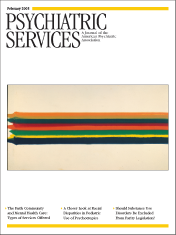One-Year Follow-Up of Persons Discharged From a Locked Intermediate Care Facility
Abstract
OBJECTIVES: This study examined outcomes during a one-year follow-up for persons who were discharged from a locked intermediate care facility in an urban area in California. The purpose of this study was to determine the extent to which persons with severe mental illness can be successfully transferred from an intermediate care facility to lower levels of care. METHODS: A total of 101 persons consecutively discharged were studied by record review and by obtaining information from facility staff members, therapists, case managers, and other community caretakers. RESULTS: During the follow-up period 56 percent of the patients who were discharged from the intermediate care facility were not able to demonstrate even minimal functioning in the community. These persons spent 90 or more days in locked or highly structured institutions that provided 24-hour care (including jail) or had five or more acute hospitalizations. However, 44 percent spent less than 90 days in these institutions and had fewer than five acute hospitalizations. Thirty-three percent were not known to have spent any time in an institution or hospital. CONCLUSIONS: The high rate of recidivism shown in this cohort suggests that the current emphasis on transferring patients from more structured, intermediate inpatient services to lower levels of care is not effective for a majority of patients. Furthermore, the poor clinical outcomes found in this cohort did not seem to be offset by any reduction in overall governmental costs because of the high use of acute and intermediate hospitalization and the costs of the criminal justice system.



